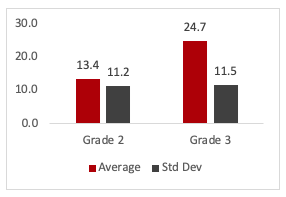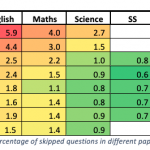- December 4, 2023
- by Educational Initiatives
- Blog
- 0 Comments
Word reading or decoding is an important skill. Needless to say, reading comprises a complex assimilation of skills. It may look effortless when we see a proficient reader read, but reading proficiency requires systematic instructions.
As per the Simple View of Reading, which is a scientific method, reading has two basic components: word recognition (decoding) and language comprehension skills (understanding). For this, the formula presented by Gough and Tunmer in 1986 is (validated by Hoover and Gough in 1990):
| Decoding (D) x Language Comprehension (LC) = Reading Comprehension (RC) |
It shows that reading comprehension (RC) skills can be predicted by measuring the decoding (D) and language comprehension (LC) abilities. Note that D and LC are multiplied to predict RC and not added. This means that strong reading comprehension skills cannot be developed with impaired or weak decoding or language comprehension skills. They both have to be strong and developed simultaneously for meaning-making (the process by which people interpret situations, events, objects, etc based on prior knowledge) to be improved.
Additionally, the main objective of Foundational Literacy and Numeracy (FLN) is to ensure children learn to read by end of Grade 3 so that they can read to learn thereafter. As per NIPUN Bharat, the benchmark is set to be 35 words per minute. This can be attained only if children are well-equipped with both D and LC. So, in the early years, word decoding or reading is an essential skill to be mastered.
Mindful of this, as part of a study undertaken with 252 students in Haryana Government Schools comprising Hindi-speaking students of grades 2 and 3, we assessed children’s word reading skills in the Hindi language. The assessment was done using pen and paper on a one-on-one basis.
Tool
Like the letter recognition task, the word reading task was also divided into two parts.:
- Word reading accuracy: Students were shown different sets of 15 words in each grade which they had to read one by one. The objective of this task was to check if the students could read the words accurately. It started from two and three-letter words without matra to two and three-letter words with matra and finally to four-letter words. Some examples of words in the tool: एक, रंग, मस्ती, सरकस
- Word reading fluency: Students were shown different sets of 100 words in each grade which they had to read one by one, in one minute. The objective of this task was to check if the students can read the words fluently. Again, the words started from two and three-letter words without matra to two and three-letter words with matra and finally to four-letter words. Some examples of words in the tool: घर, भालू, यज्ञ, प्रार्थना
The task was divided into accuracy and fluency because speed and accuracy are required to attain mastery of this skill. Students who could read the word as a whole word were scored 1 and students who read syllable by syllable without blending them into words were scored 0 in these tasks.
Result
In alignment with LiRIL (Literacy Research in Indian Languages) report, we found that students could decode words below grade level students decode words below grade level. Our findings echo the findings of this report. We found that students could decode words below grade level. For example, झगड़ा which is a familiar word that contains a low-frequency letter (a letter that is not commonly used) and a simple matra should have been identified by most of the students. However, only 41.3 % of the students in Grade 2 and 68% in Grade 3 were able to read the word making it fall under the least identified word category.
The table below presents the least and most identified words. In both grades, words with sanyuktakshara (conjoined consonants), matra, or half letters are the least recognized words. The highest recognized words in all the grades are 2 letter words with no matra followed by two-letter words with simple matra in Grade 3.
| Gr | Least identified words | Most identified words |
| 2 | मस्ती झगड़ा सरकस रंग | चल एक कलम बतख |
| 3 | ऋषि क्रमांक विज्ञान झगड़ा | चल एक काला नदी |
Table 1: The table shows the least and highest identified words in both grades.
Figure 1 shows the average accuracy of students in Grades 2 and 3. 52.3% of the students in Grade 2 and 75.4% in Grade 3 were able to read the words correctly. An exponential rise in the average accuracy can be observed from grade 2 to 3 with decreasing standard deviation which implies that the competence is increasing. Fascinatingly, this is also in congruence with the rise in letter accuracy scores (ref Figure 2).

Worryingly, 29% of the students in Grade 2 and 4.8% in Grade 3 were not able to read even a single word. It is worthwhile to note that 16.7% of the students in Grade 2 and 17.5% in Grade 3 were able to accurately decode all 15 words.
 Figure 3: Percentage of students scoring 0 and 100% in word reading accuracy task.
Figure 3: Percentage of students scoring 0 and 100% in word reading accuracy task.
Word reading fluency is measured in counts per minute. Figure 4 shows that on average, Grade 2 students were able to correctly read 13.4 words per minute which increased to 24.7 words in Grade 3. As per the NIPUN Bharat mission, the benchmark is to read 35 words per minute. The graph clarifies that the students are way below the benchmark. This is in line with the LiRIL findings: Even by the end of Grade 3, and despite the considerable instructional time spent on these, many students had not acquired fluency with the scripts. Swarachinhas and jodaksharas, in particular, presented significant challenges.
 Figure 4 Performance of students in word fluency task which is measured in counts per minute (cpm).
Figure 4 Performance of students in word fluency task which is measured in counts per minute (cpm).
Discussion and Conclusion
It is assumed that since Hindi is a transparent language in which the name and sound of the letters are the same, blending sounds to form words would happen automatically. Contrary to this belief, in Indic scripts, word decoding requires a lot of scaffolding and practice with systematic instructions. This is owing to the fact that Indic scripts are more visuospatial complex (Nag, 2007) as the swarachinhas (vowel signs) can either be placed to the right, left, above, or below the akshara. In Hindi, the diacritic rule (marks placed before, after, above, or below a letter) of the vowel sign attaching differently to moolasksharas (basic letters) makes the script complex. This in turn makes learning to read, a complicated process. We saw that betterment in the letter accuracy task also improved the word accuracy scores from Grade 2 to 3.
Can we then say that letter recognition is a predictor of word reading?
Quoting from my previous blog, I would like to reaffirm that ‘impairment in letter fluency causes struggle in decoding skills as children do not have freed up working memory to use to decode words. Their working memory is used to identify the individual sounds/letters in the word instead of blending the sounds to pronounce the word. Until mastery in fluency is attained, students will always struggle with the cognitive load to identify and blend letters/sounds over automatically (from their memory) reading the word’.
On top of that, this, passage reading is introduced in Grade 1 itself when children are still learning to recognize letters and read words. Our data suggest that considerable opportunities to strengthen word reading skills should be provided to students.
Strategies to develop word reading skills:
- Model the processes used by proficient readers to read words.
- The prerequisite for comprehending volumes of text is the parallel processing of letters. This happens when the letter-by-letter decoding function moves to the visual word form area of the brain, which recognizes words as if they were faces. So, teaching and curriculum should promote the instruction of individual letters and independent student practice with teacher feedback; then, students may achieve parallel processing. (Abadzi, 2017)
- Engage children to read aloud and give words that follow a pattern together.
_____
References
Abadzi, H. (2017) Turning a molehill into a mountain? How reading curricula are failing the poor worldwide. (UNESCO, IBE Springer) https://www.researchgate.net/publication/315848696_Turning_a_molehill_into_a_mountain_How_reading_curricula_are_failing_the_poor_worldwide
Hoover, W.A., Gough, P.B. The simple view of reading. Read Writ 2, 127–160 (1990). https://doi.org/10.1007/BF00401799
Menon, Shailaja and Krishnamurthy, Ramchandar and Kutty, Sajitha and Apte, Neela and Basargekar, Abha and Subramaniam, Sneha and Nalkamani, Mounesh and Modugala, Madhuri (2017) Literacy Research in Indian Languages (LiRIL): Research report of a Study of Literacy Acquisition in Kannada and Marathi (2013-2016). Project Report. Tata Trusts and Azim Premji University, Bengaluru.
Nag, S. (2007). Early reading in Kannada: the pace of acquisition of orthographic knowledge and phonemic awareness. Journal of Research in Reading, 30 (1), 7-22. http://eli.tiss.edu/wp-content/uploads/2018/08/Nag-2007-JRIR_329.pdf
NIPUN Bharat, https://www.education.gov.in/sites/upload_files/mhrd/files/nipun_bharat_eng1.pdf

